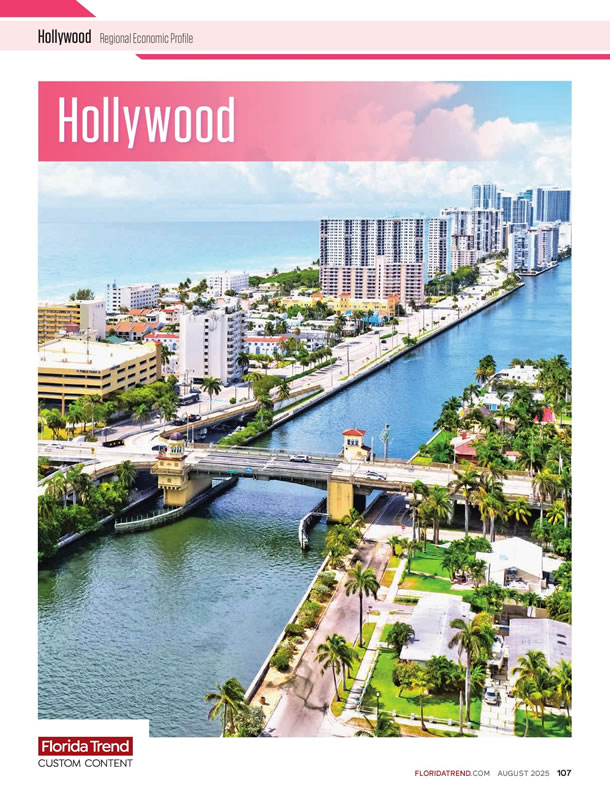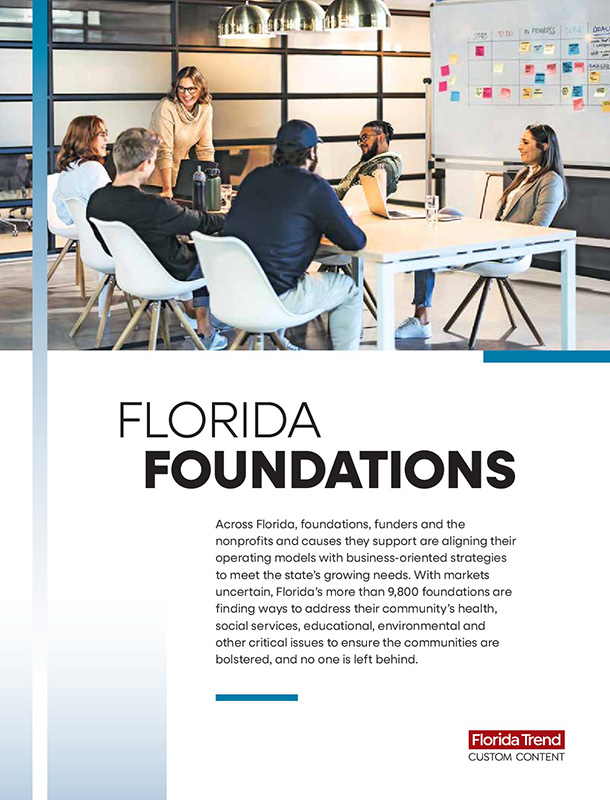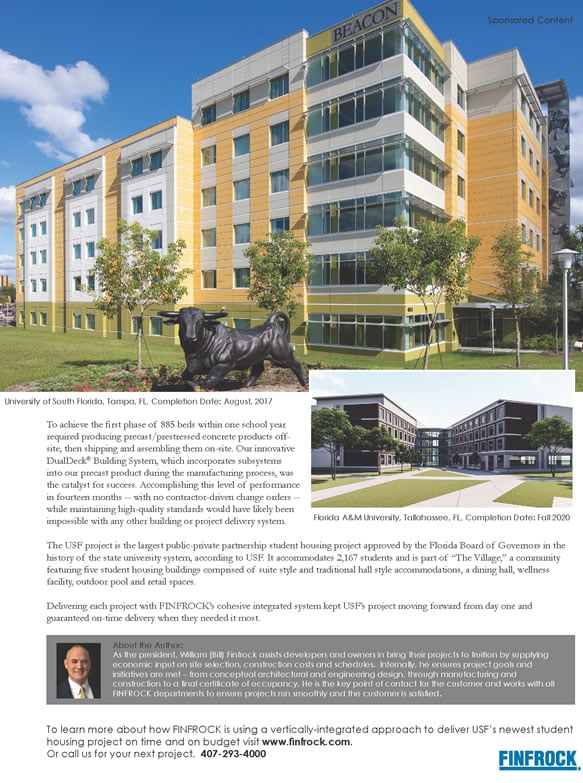In recent years, however, a radically different approach to community development has taken root in Florida, and its followers are nearly Messianic in their embrace of it. Called traditional neighborhood design (TND) or neo-traditional or new urbanism, it has found a following in Florida largely because of the appealing examples set by Seaside in the Big Bend and Celebration near Orlando. Indeed, Florida ranks second nationally with 19 TND developments, behind only California with 22, according to New Urban News, an Ithaca, N.Y., newsletter that follows TND trends. "Florida is ahead of the curve nationally because of Seaside," says editor/publisher Robert Steuteville. "Seaside has a wonderful feeling -- even though it's a resort and not part of the 'real world' in many ways. Many people have visited Seaside and asked themselves, 'Why couldn't something like that be developed in our neighborhood?'"
New communities are springing up in Jacksonville, Gainesville, Orlando, Vero Beach, Palm Beach County and Miami. Although no two TNDs are alike, they frequently share such TND features as:
Narrow lots to create higher housing density and more visually interesting streetscape;
Smaller front yards to bring homes closer to the street, and front porches to encourage neighborly interaction;
A mix of different housing types on the same street, including rentals;
Narrow, straight streets that form a grid and slow the flow of traffic;
A retail-office center that serves as "downtown" for the neighborhood;
Sidewalks and narrow streets to create a pedestrian-friendly environment;
Rear garages, often with overhead apartments, and rear alleys to reduce the visual impact of family vehicles;
"People are one of the best amenities you can offer," says Joel Embry, president of HomeTown Neighborhoods Inc. and founder of Amelia Park, a 400-home TND community just underway in Fernandina Beach, north of Jacksonville. "Civic life is something a typical suburb doesn't offer. Amelia Park and other communities using these principles respond to a yearning for social interaction and engagement with their neighbors that other developments don't offer."
This notion of putting neighbors in touch with each other is an abiding theme of TND enthusiasts. "In America, people love their homes, the private realm, but they don't like the public realm anymore," says Andres Duany, who with his wife, Elizabeth Plater-Zyberk, created the Miami architectural firm of Duany Plater-Zyberk & Co. (DPZ) that has championed alternative design concepts in some 80 communities over two decades. "The goal with TND is to create a public realm that people love."
Still, TND remains a boutique concept in an industry of giants. For example, my firm's market studies indicate a lack of understanding of TND and its goals among homebuyers. We find about one-third of Florida homebuyers like the concept, one-third hate the idea and the remainder don't understand the idea or are undecided.
"I emphatically feel this will never work in a large project," says Anthony Trella, an industry consultant and president and CEO of The Meranth Co., a real estate advisory in Deerfield Beach. "I have yet to see it demonstrated that this is a profitable concept on a large scale."
Trella, who has 25 years experience in large building and development companies, says the TND approach is both idealistic and naive. "It is presumptuous on the part of the planners and government officials who are embracing this concept to say people will be friendlier and more neighborly because you change the design of the street. If people on a cul-de-sac in a conventional subdivision can't be friendly with each other, who can? Basically, people are people, and very few of us have the desire or the ability to be social butterflies."
The Florida model for TND is Seaside, a 350-home resort community on the Gulf of Mexico in Walton County designed in 1980 by DPZ for developer Robert Davis. Nearly two decades later, all residential lots have been sold, primarily to second-home buyers. Seaside's narrow cobblestone streets, picket fences and two-story New England-style houses with front porches have been featured in numerous architectural publications and provide an example for other Florida developers.
But Seaside is a unique development, says Trella, "It's not primary housing and it's on a small scale. It's great for affluent people on vacation, but not the masses. It's not how we will shelter America."
Seaside was clearly the inspiration for Windsor, a luxury second-home resort community in Vero Beach launched in 1989 as the brainchild of Galen Weston, president of Toronto-based food and retail conglomerate Torwest, and his wife, Hilary. To date, about 100 lots in the 395-lot gated community have been sold to buyers from Canada, Europe and the Northeast U.S. Homes range from $575,000 to more than $3 million.
"Galen and Hilary Weston had seen Seaside and wanted a more sophisticated development," says Luis Dominguez, Windsor managing director and vice chairman. "The houses are close to the street with an atmosphere that is reminiscent of Charleston or Nantucket. In this development, the hook is the architecture, the way Windsor looks." Befitting its position as a vacation getaway for the affluent, Windsor also features a beach club, a golf course designed by Robert Trent Jones Jr., tennis courts, a village center with executive suites, an equestrian center, gun club and croquet greens.
The Disney Company also looked to Seaside as a model for Celebration, its 4,900-acre, high-profile community southwest of Orlando modeled after small American towns of the past [FT, November 1996]. Celebration has tapped the talents of internationally renowned architects to design the Disney-owned public buildings. With smaller lots, and a "front-porch" residential orientation, Celebration closely follows the principles of TND. To date, about 400 homes at Celebration are occupied, with home prices starting at $167,000 and rising to more than $1 million.
In answer to critics like Trella, who doubt that TND presents opportunities for economies of scale, TND advocates say one of its financial attractions is being able to take an ordinary tract of land, design a higher density development and sell smaller lots -- in some cases at premium prices.
"Compared to a conventional subdivision next door, I think a neighborhood project can charge a premium if they get it right," says Steuteville, the newsletter publisher. "People will pay extra for a quality public realm -- the type of street they want to live on and the type of place they would want to walk. The developers who do it right can charge more because they're offering a real amenity to a certain percentage of the population."
Abacoa, a 2,050-acre project in Jupiter by Abacoa Development Co. is the first large-scale community in Palm Beach County to embrace the TND concept. A true mixed-use development, Abacoa will have a town center, retail stores, entertainment, rental housing and a "big box" center on its periphery, as well as a work campus, golf course and three public schools. Adding to the diversity, Abacoa will be the home to Florida Atlantic University's north campus, a state honors college, and a new spring training baseball stadium for the St. Louis Cardinals and Montreal Expos, which opened in February.
Homebuilder DiVosta and Co., is building single-family homes and neighborhood squares. "It's important for buyers to get a flavor of the community," says Scott Hedge, project architect for Abacoa. "Since you're selling a community, you have to describe that visually." Abacoa will have about 6,250 housing units, including 1,200 to 1,500 rental units, when completed in approximately 2010.
To maintain the "neighborhood" flavor in such a large project, Abacoa will have several smaller commercial centers, and the ability to put small "mom and pop shops" around neighborhood squares. "The zoning code ensures that Abacoa will be built out in a TND manner. That's important for the overall community standpoint," says Hedge.
Walking distance
Sales are expected to begin in late 1998 at Salamanca, a 160-acre Kendall development by Pulte Homes that will include 1,500 to 1,600 housing units, plus a neighborhood retail center. "We want to distinguish ourselves among a sea of competition that's out there," says Tim Hernandez, Pulte marketing vice president. "In general, the development that's been done in south Florida from a design standpoint encourages people to get in a car for everything. At Salamanca, residents can walk places."
Pulte's target market is young families, couples and singles, with an unusually wide range of home types and pricing -- perhaps from $90,000 to $230,000. "The traditional neighborhood design provides for accessory dwellings with each unit, such as mother-in-law suites or quarters for a maid or nanny. As the extended family is very commonplace among Hispanics, this should be appealing for that portion of the Kendall market."
A TND development that's further along is Haile Village Center, a 200-home project by Robert Kramer and Matthew Kaskel within the 1,700-acre Haile Plantation development west of Gainesville. When completed, Haile Village Center will include single-family homes, multifamily units, a 50-unit assisted care facility, a lodge and conference center, and apartments above the 200,000-square-foot downtown retail/office center. "One of the real successes is how well the mix of residential and commercial has been working," says Kramer, architect and president, Haile Plantation Corp. "Many people are afraid of that concept. But the acceptance of this type of commercial development in a neighborhood setting is pretty obvious. The residents take more pride in it, as opposed to a strip center on the highway."
As undeveloped land surrounded by development, Amelia Park is a natural for traditional neighborhood design, according to Embry. The 106-acre neighborhood in Fernandina Beach, designed by DPZ, is located near the city's historic downtown and already has supermarkets and medical facilities nearby.
Critics unimpressed
But critics remain unimpressed by TND successes, arguing that the new approach is out of step with the realities of the Florida market. They note, for example, market studies showing most buyers prefer a neighborhood where home prices are similar. A large-scale conventional development can offer 15 to 30 housing types in separate areas. In contrast, with the TND approach, a $500,000 home might be a block over from a $100,000 home.
Another factor is cost. "Only a minority of people have stepped up to purchase these homes," says critic Trella. "One reason is that almost without exception homes in neo-traditional planned communities tend to be more expensive than comparable homes in other communities."
The correct location and mix of retail centers in a TND neighborhood is another matter of concern. "The new urbanism recognizes the realities of modern retailing," says Matt Shannon, DPZ development director. "Grocery stores and 'big box' retailers up to a certain size can be accommodated in a well-designed neighborhood center, but more often they are located on a major transportation corridor, with higher visibility and better access to a regional road network."
However, the smaller "downtown" retailers must depend on the immediate neighborhood for support. "In many of the neo-traditional designs I've seen, there simply aren't enough rooftops to support those businesses," Trella says. "The neighbors won't shop exclusively there, and they don't draw people from outside the community. It's a recipe for financial disaster."
Street design and traffic patterns are another controversial issue. Far more buyers prefer curved streets and cul-de-sacs, than a rectangular grid. Residents also prefer limited access collector roads to narrow streets filled with traffic-slowing stop signs. "If you live in the middle of a 500-acre project, it might take you 20 minutes to get out, under the purist grid concept," Trella says. "You simply cannot ignore the love affair Americans have with their cars."
Detached garages and rear alleys also run counter to some market studies that consistently show buyers prefer an attached garage where they can walk directly into the kitchen or utility room -- thus avoiding Florida's rain and humidity, as well as potential security problems walking into the house after dark.
In fact, security may be the biggest issue facing TND developers, who emphasize community involvement -- the same approach taken by CrimeStoppers and other neighborhood organizations. "You have crime everywhere in Florida," says Hernandez. "One thought is to keep everyone out. Another approach is to make the neighborhood more communal, so there are more eyes on the street. If people are sitting on the front porch, there won't be much crime on the street."
The neighborhood program is fine, say TND critics, but why not supplement that approach with a security gate? Walls to limit access also makes sense -- especially in second-home communities, senior citizen developments, and primary home neighborhoods with high numbers of dual-career families, when no one may be watching the street. Police reports usually show that a gated community generally has a lower crime rate than an open development.
In addition, move-up, second-home and luxury-home buyers tend to prefer gated communities, which are perceived to have greater prestige. As one developer put it: "Heaven has gates, but anyone can go to Hell."
Referring to Amelia Park, Embry agrees that a large part of the market prefers a gated community or conventional subdivision. "There is a generous supply of that product. But for the portion of the market that would prefer living in a more interactive neighborhood, the supply is extremely limited. That's really where the opportunity is."
For Florida developers, the next decade will determine whether or not traditional neighborhood design will be widely accepted. "The marketplace really determines the success or failure of these projects," Trella says. "I don't believe we have yet found the formula to make all our life's desires fit into an ideal community. Maybe we never will.
Contributing Editor Lewis M. Goodkin is president of Miami-based Goodkin Research Corp.
TND OR NOT TND
A Hybrid Approach
Lakewood Ranch developers try to fuse neo-traditional design and the hard realities of the marketplace.
By David Villano
The traditional neighborhood design (TND) community to watch in Florida may be Lakewood Ranch off I-75 in Manatee and Sarasota counties. Upon projected build-out in 2015, the 5,500-acre development will include a commercial district, corporate center, schools, medical facilities and as many as 7,000 single-family homes. The project's developers, SMR Communities, have structured the development (in part by using Community Development Bonds to pay for huge infrastructure requirements) so that it has a quasi-governmental identity. Some see a new city emerging as the project grows. SMR is a division of Schroeder-Manatee Inc., which is controlled by Milwaukee's Uihlein family, founders of Schlitz Brewing Co. Schroeder-Manatee owns the 28,000-acre Schroeder-Manatee Ranch that surrounds Lakewood Ranch, giving the project virtually limitless room for expansion.
But is Lakewood Ranch really a TND community? At first glance, the community shows many features of traditional neighborhood design: homes with large porches facing the street; a network of lakes, parks and green space linked together by miles of footpaths; drugstores, dry cleaners and other business services within walking distance. Developers envision a self-contained town where residents can work, study and play all within a few blocks of home. "We've tried to tie everything together," says Roger Postlethwaite, president of Sarasota's SMR Communities. "We're continually driven by the belief that community is created by the interaction of people. As developers, our toughest challenge is finding ways to facilitate that."
A closer look at Lakewood Ranch, however, shows a development crafted by SMR Communities' market research department. Included are some design and planning elements that TND purists say promote sprawl and civic disengagement. For example: cul-de-sacs, a TND no-no, abound; and at least two of the development's five "villages" will be gated. More heretical to TND orthodoxy is Lakewood Ranch's segregation of homebuyers along lifestyle and socio-economic lines. Some neighborhoods have been designed for first-time buyers, while others are meant to appeal to empty-nesters, affluent retirees or couples with growing families.
Postlethwaite rejects the charge that Lakewood Ranch is essentially a conventional, old-school community with a bit of TND window-dressing. He says Lakewood Ranch, like a growing number of other planned communities around the country, is a sensible fusion of TND theory with the cold, hard realities of the marketplace. For example, SMR's research revealed that affluent buyers prefer walled communities. It also revealed, to the developer's surprise, a dislike for community designs that encourage socio-economic mingling.
"If you want to be successful, you have to give people what they want," says Jim Doyle, vice president, marketing for SMR Communities. "A lot of these ideas for creating a traditional neighborhood environment sound great, but not all of them make sense from a marketing standpoint."
Research continues at Lakewood Ranch long after homebuyers move in. As an example, Postlethwaite tells of a recent neighborhood "focus group" meeting of lake front property residents. Following their suggestions, the developers added a wharf, boat ramps and altered landscaping. He believes that kind of responsiveness encourages civic involvement and strengthens community bonds more than allegiance to a philosophical approach that mandates through-streets, front porches and corner drugstores.
Postlethwaite says his formula is a proven success. When he led the development team at The Meadows, a planned community in Sarasota County, Meadows residents consistently recorded the highest voter turnout rate in the county. Should a developer care whether residents show their civic engagement by turning out to vote? "If he doesn't," Postlethwaite says, "he should be in another business."












